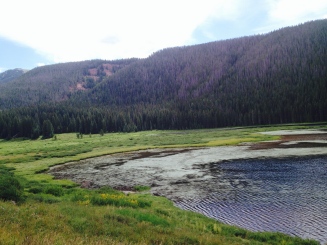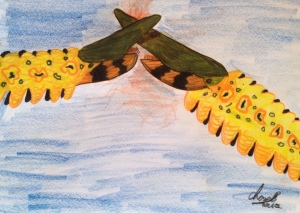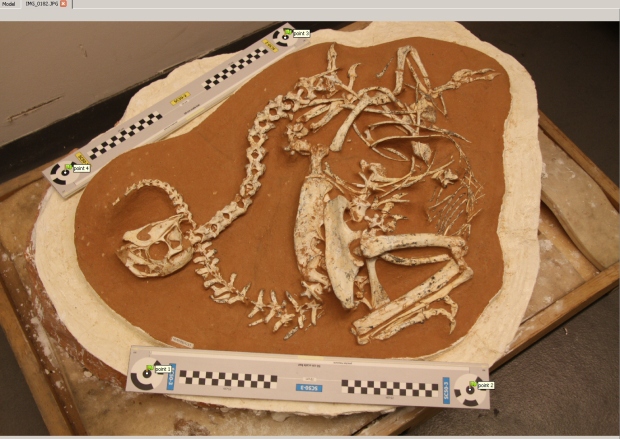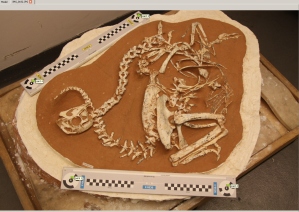Time for a new series! Let’s get started!! In this series, I will talk about various formations, continents, and geological structures and the prehistoric ecosystems they help us to reconstruct. I hope you enjoy!
Hello everyone, welcome to Stunning Strata #1. This time around we have the Candeleros Formation, a formation I have actually been studying as a pet project for a while now:
The Candeleros Formation is part of the Neuquen group and outcrops in the Rio Negro, Mendoza, and Neuquen provinces of Argentina. It dates to around 99-92 million years ago. This formation was made famous among the paleontological community, at least, by the discovery of Giganotosaurus carolinni.
The Candeleros Formation dates to the Cenomanian stage of the Cretaceous, a time when the carcharodontosauroids were the top predators on land and titanosaurs were the most diverse sauropod group. The Candeleros Formation played host to many of these animals. From the formation we have the sauropod Andesaurus, a medium sized basal titanosaur. Predatory dinosaurs found in the Candeleros Formation include the giganotosaurine carcharodontosaurid Giganotosaurus carolinni, the medium-sized abelisaurid Ekrixinatosaurus novasi, the small unenlagiine Buitreraptor gonzalezorum, and the large basal coelurosaurian (and possible tyrannosauroid) Bicentenaria argentina. The alvarezsaurid theropod Alnashetri cerropoliciensis is also known from the Candeleros.
Based on the remains of theropod lineages found in other areas of South America (i.e. Oxalaia quiliombensis from the Cenomanian of Brazil) and by comparing the Candeleros Formation to other formations of the same time period which contain similar floras and faunas, we can infer that taxa representing theropod lineages like the spinosaurids co-existed with the animals found in the Candeleros Formation. Therefore, the Candeleros Formation represents an ecosystem with fauna similar to the Bahariya Formation of Egypt and the Kem Kem beds of Morocco. This hypothesis is also supported by the fact that the environment represented by the Candeleros Formation was similar to that of the Bahariya Formation and the Kem Kem Beds. The habitat which the Candeleros Formation represents was a braided river system which a menagerie of fish, turtle, amphibian, mammal, arthropod, and dinosaur species called home. Buitreraptor may have even had adaptations specially suited for exploiting the bountiful fish of these ancient streams.
The primitive snake Najash rionegrina may also have been a predator of the wetlands, slithering through the water as it searched for prey. I should also note that there is ample evidence that suggests N. rionegrina assumed a subterranean lifestyle. Other animals, it seems, were more at home surviving off the land then off the wetlands…

Piney Lake in Vail, Colorado. The Candeleros Ecosystem was probably similar to that of Piney Lake’s.
Photo by the author, 2014.
The Candeleros Formation played host to a number of terrestrial animals, namely dinosaurs. The first I want to mention is Bicentenaria argentina, a possible basal tyrannosauroid. I hypothesize this animal was a predator of small game, taking up a niche which would allow little if any competition with the megapredators of the area. B. argentina was probably the leopard to G. carolinni’s African lion. Giganotosaurus itself is a pretty interesting animal. This highly derived carcharodontosaurid was the largest predatory animal found in the Candeleros ecosystem. Well for right now, anyway. It is proposed that large carcharodontosauroid theropods were specialist hunters of sauropods. If so, G. carolinni lived in the carcharodontosaur version of paradise. So far, three medium-sized sauropods have been formally described from the Candeleros Formation. These are the basal titanosaurid Andesaurus delgadoi and the rebbechisaurids Limaysaurus tessonei and Nopcsaspondylus alarconensis. The rebbechisaurids are famous for their rake-like jaws, which may have been adaptations for a grazing lifestyle. Titanosaurs had needle-like teeth, which were probably used to rip leaves off trees. Indeterminate iguanodont tracks have also been found from the formation. I’ve heard of partial, undescribed iguanodont skeletons from the Candeleros gaining dust in collections, but I haven’t been able to find anything in the literature on the subject. Nevertheless, the track makers may have also constituted a food source for the massive carcharodontosaurids present in their ecosystem.
G. carolinni wasn’t always killing. It must have co-existed peacefully with sauropods at times, just like lion prides and zebra herds do in the modern African Savannah.

Giganotosaurus (foreground) rests in the plains of the Candeleros Formation while Andesaurus browses in the background.
Illustration by the author.
Colored pencils on paper, 2015.
The abelisaurid Ekrixinatosaurus novasi was also a resident of the Candeleros Formation ecosystem. E. novasi may have competed with Giganotosaurus for prey, but was way smaller compared to its giant carcharodontosaurid contemporary. At an estimated 26 feet long, a fully-grown Ekrixinatosaurus would have been easily overpowered by an adult 42 foot long, 8 ton G. carolinni.
We should also look at the smaller animals which make up the prehistoric fauna of the Candeleros Formation. These include reptiles, turtles, fish, and amphibians (specifically frogs). Two species of the turtle Prochelidella have been collected from Candeleros Formation sites. The running crocodylomorph Araripesuchus patagonicus is known from the Candeleros as well. Araripesuchus was a small predator, preying on the various animals which called the Candeleros wetlands home. Alnashetri was a small alvarezsaurid that most likely led an omnivorous lifestyle. Unfortunately, this dinosaur is only known from hindlimb material.
References
1. F. Ortega, Z. Gasparini, A.D Buscaloni and J. O. Calvo. 2000. “A new species of Araripesuchus (Crocodylomorpha, Mesoeucrocodylia) from the Lower Cretaceous of Patagonia (Argentina).” Journal of Vertabrate Paleontology 20(1): 57-76.
2. Baez, Ana M. , Muzzopappa, Paula, and Nicoli, Laura. 2007. “Anurans from the Candeleros Formation (?Cenomanian-Turonian) of west-central Argentina: new evidence for pipoid evolution.” Cretaceous Research 28 (2007): 1005-1016.
3. Sánchez, Maria Lidia; Heredia, Susana & Calvo, Jorge O. 2006. “Paleoambientes sedimentarios del Cretácico Superior de la Formación Plottier (Grupo Neuquén), Departamento Confluencia, Neuquén.” Revista de la Asociación Geológica Argentina 61(1): 3-18.
4. Wichmann, R. 1929. “Los Estratos con Dinosaurios y su techo en el este del Territorio del Neuquén.” Dirección General de Geología, Minería e Hidrogeología Publicación 32: 1-9.
5. Apesteguía, Sebastián; Hussam Zaher. 2006. “A Cretaceous terrestrial snake with robust hindlimbs and a sacrum”. Nature 440 (7087): 1037–1040.
6. Calvo, J. O. and Salgado, L. 1995. “Rebbachisaurus tessonei sp. nov. A new sauropod from the Albian-Cenomanian of Argentina; new evidence on the origin of the Diplodocidae.” Gaia, 11: 13-33.
7. Salgado, L., Garrido, A., Cocca, S. E., and Cocca, J. R. 2004. “Lower Cretaceous rebbachisaurid sauropods from Cerro Aguada Del León, Neuquén Province, northwestern Patagonia, Argentina.” Journal of Vertebrate Paleontology, 24(4): 903-912.
8. Apesteguía, Sebastián. 2007. “The sauropod diversity of the La Amarga Formation (Barremian), Neuquén (Argentina)”.Gondwana Research 12 (4): 533–546.
10. Calvo, J.O. & Bonaparte, J.F. 1991. “Andesaurus delgadoi n. g. n. sp. (Saurischia, Sauropoda) a titanosaurid dinosaur from the Río Limay Formation (Albian-Cenomanian), Neuquén, Argentina.” Ameghiniana. 28: 303-310.
11. Mannion, P. D. and Calvo, J. O. ” Anatomy of the basal titanosaur (Dinosauria, Sauropoda) Andesaurus delgadoi from the mid-Cretaceous (Albian–early Cenomanian) Río Limay Formation, Neuquén Province, Argentina: implications for titanosaur systematics.” Zoological Journal of the Linnean Society, 163 (2011): 155-181.
12. Novas, F.E., Salgado, L., Calvo, J.O., & Agnolin, F. 2005. “Giant titanosaur (Dinosauria, Sauropoda) from the Late Cretaceous of Patagonia. ” Revista del Museum Argentino de Ciencias Naturales 7(1): 37-41.
13. Jorge Calvo, David Rubilar-Rogers and Karen Moreno .2004. “A new Abelisauridae (Dinosauria: Theropoda) from northwest Patagonia”. Ameghiniana 41 (4): 555–563.
14. Leanza, H.A.; Apesteguia, S.; Novas, F.E. & de la Fuente, M.S. 2004. “Cretaceous terrestrial beds from the Neuquén Basin (Argentina) and their tetrapod assemblages.” Cretaceous Research 25(1): 61-87.
15. J.O. Calvo .1990. “Un gigantesco theropodo del Miembro Candeleros (Albiano–Cenomaniano) del la Formación Río Limay, Patagonia, Argentina”, VII Jornadas Argentinas de Paleontología de Vertebrados. Ameghiniana 26(3-4): 241
16. Calvo, J.O. and Coria, R.A. 1998. “New specimen of Giganotosaurus carolinii (Coria & Salgado, 1995), supports it as the largest theropod ever found.” Gaia, 15: 117–122.
17. Coria, R.A. & Salgado, L. 1995. “A new giant carnivorous dinosaur from the Cretaceous of Patagonia.” Nature 377: 225-226.
18. Coria, R. & Salgado, L. .1996. “Dinosaurios carnívoros de Sudamérica”, Investigación Sciencia, 237: 39-40.
19. Matthew T. Carrano, Roger B. J. Benson & Scott D. Sampson .2012. “The phylogeny of Tetanurae (Dinosauria: Theropoda)”, Journal of Systematic Palaeontology, 10(2): 233.
20. J.O. Calvo .1999. “Dinosaurs and other vertebrates of the Lake Ezequiel Ramos Mexía area, Neuquén-Patagonia, Argentina”. In Y. Tomida, T. H. Rich, and P. Vickers-Rich, Proceedings of the Second Gondwanan Dinosaur Symposium, National Science Museum Monographs 15: 13-45.
21. Seebacher, F. 2001. “A new method to calculate allometric length-mass relationships of dinosaurs”. Journal of Vertebrate Paleontology 21 (1): 51–60.
22. Therrien, F.; Henderson, D.M. 2007. “My theropod is bigger than yours…or not: estimating body size from skull length in theropods”. Journal of Vertebrate Paleontology 27 (1): 108–115.
23. Gianechini, F.A.; Apesteguía, S.; Makovicky, P.J .2009. “The unusual dentiton of Buitreraptor gonzalezorum (Theropoda: Dromaeosauridae), from Patagonia, Argentina: new insights on the unenlagine teeth”. Ameghiniana 46 (4): 29R.
24. Makovicky, Peter J.; Apesteguía, Sebastián; Agnolín, Federico L. 2005. “The earliest dromaeosaurid theropod from South America”. Nature 437: 1007–1011.
25. Makovicky, P. J.; Apesteguía, S. N.; Gianechini, F. A. .2012. “A New Coelurosaurian Theropod from the La Buitrera Fossil Locality of Río Negro, Argentina”. Fieldiana Life and Earth Sciences 5: 90.
26. Novas, F.E., Ezcurra, M.D., Agnolín, F.L., Pol, D. and Ortíz, R. .2012. “New Patagonian Cretaceous theropod sheds light about the early radiation of Coelurosauria.” Revista del Museo Argentino de Ciencias Naturales, nueva serie, 14: 57–81.
27. Kellner, Alexander W.A.; Sergio A.K. Azevedeo, Elaine B. Machado, Luciana B. Carvalho and Deise D.R. Henriques. 2011.”A new dinosaur (Theropoda, Spinosauridae) from the Cretaceous (Cenomanian) Alcântara Formation, Cajual Island, Brazil”.Anais da Academia Brasileira de Ciências 83 (1): 99–108.
28. Medeiros, M.A. .2006. “Large theropod teeth from the Eocenomanian of northeastern Brazil and the occurrence of Spinosauridae”. Revista Brasileira de Paleontologia 9: 333–338.
29. Catuneanu O., Khalifa M.A. & Wanas H.A. .2006. “Sequence stratigraphy of the Lower Cenomanian Bahariya Formation, Bahariya Oasis, Western Desert, Egypt”. Sedimentary Geology 190 (1-4): 121–137. 29.
30. Weishampel, David B; et al .2004. “Dinosaur distribution (Late Cretaceous, Africa).” In: Weishampel, David B.; Dodson, Peter; and Osmólska, Halszka (eds.): The Dinosauria, 2nd, Berkeley: University of California Press. Pp. 604.
31. Khalifa M.A. & Catuneanu O. .2008. “Sedimentology of the fluvial and fluvio-marine facies of the Bahariya Formation (Early Cenomanian), Bahariya Oasis, Western Desert, Egypt”. Journal of African Earth Sciences 51 (2): 89–103.
32. Tanner L.H. & Khalifa M.A. .2010.”Origin of ferricretes in fluvial-marine deposits of the Lower Cenomanian Bahariya Formation, Bahariya Oasis, Western Desert, Egypt”. Journal of African Earth Sciences 56 (4-5): 179–189.32.
33. Weishampel, David B; et al. .2004. “Dinosaur distribution (Late Cretaceous, Africa).” In: Weishampel, David B.; Dodson, Peter; and Osmólska, Halszka (eds.): The Dinosauria, 2nd, Berkeley: University of California Press. Pp. 604-605.








